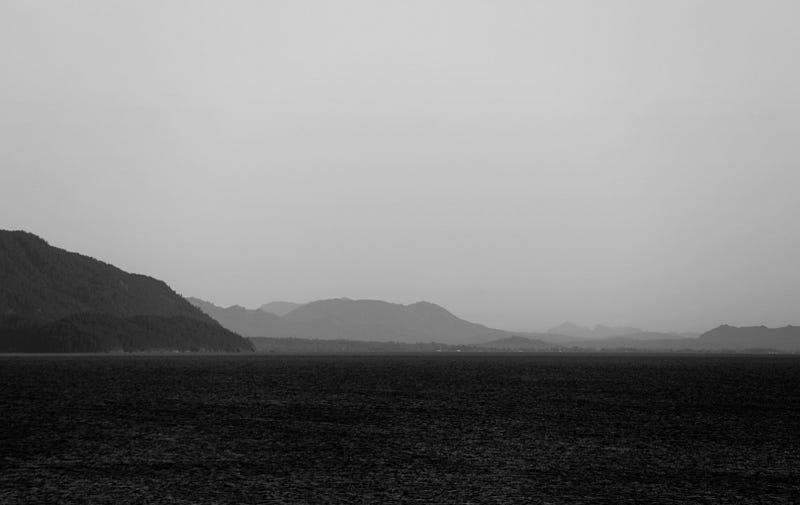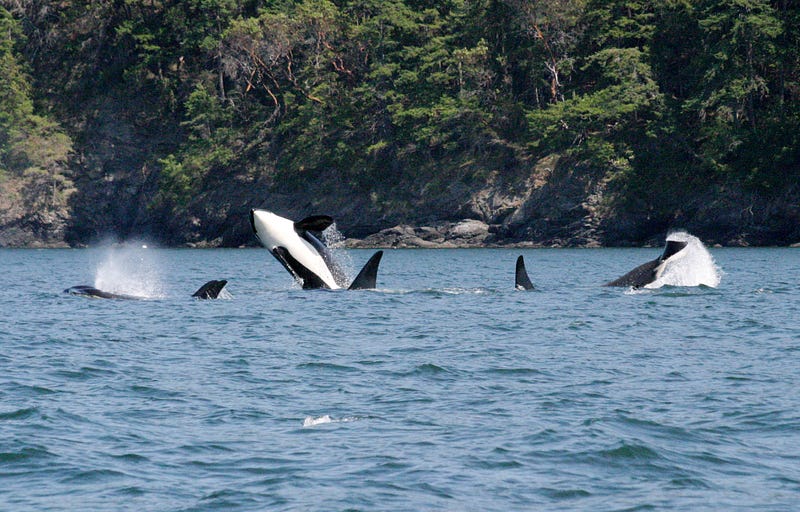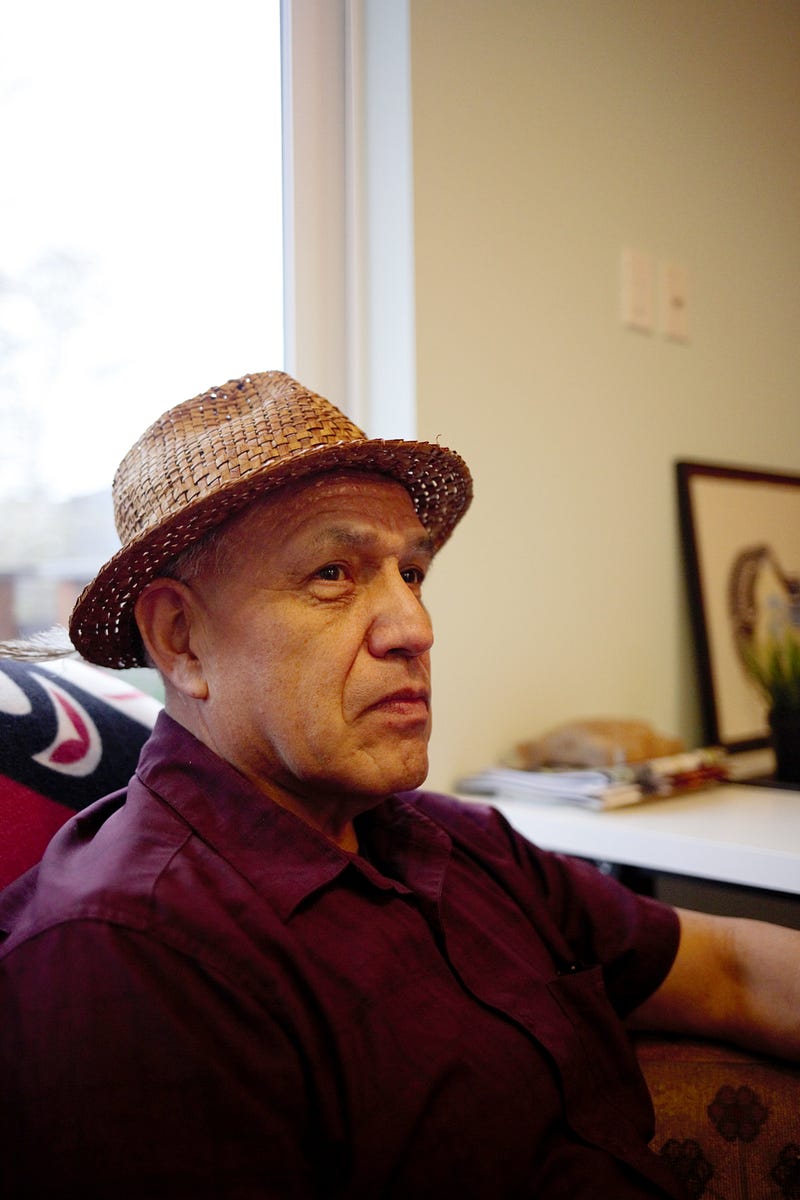A Mother’s Mourning
The reality of extinction illustrated by a heartbroken mother orca
Story & Photos by Mathew Roland

As the summer sun beat down on the waters of Puget Sound, it illuminated black dorsal fins and small towers of mist that evaporated quickly in the heat. On the morning of July 24, 2018, an orca calf was born into the J-Pod. The newborn was observed swimming by its mother’s side.
Field biologists from the Center for Whale Research boarded their boat and left Friday Harbor. They traversed across Haro Strait to document the latest member of the J-Pod, one of three pods that form the critically endangered Southern Resident Killer Whale population.
After locating most of the J-Pod they noticed two whales were missing. Several hundred yards away they found Tahlequah, a 20-year-old female, and her 8-year-old son, Notch. Tahlequah was making unusually long dives and observed pushing something through the water. When she broke the surface it became clear she was pushing a dead calf on her snout.
As days turned into nights Tahlequah continued carrying her dead calf sometimes pulling it in her mouth, other times pushing it, repeatedly dropping it and diving to bring it back to the surface. As the pod swam north, Tahlequah staggered behind. Her story went viral throughout the Pacific Northwest region and garnered international headlines. Other members of the pod took turns floating the calf to give Tahlequah time to rest.
Nine days after its birth and death, the calf began to decompose. Nevertheless, Tahlequah persisted in what scientists described as ‘unprecedented behavior.’ After more than two weeks and 1,000 miles, Tahlequah let go. Her calf sunk to the bottom of the Puget Sound and she caught up with her pod.
The southern resident orcas live in the waters off Seattle, Vancouver and Victoria, British Columbia. The death of this calf will having lasting impacts on this population which hasn’t had a single successful birth in the last three years. The threat of losing their main food supply is the biggest issue facing the southern resident whales. Coupled with contaminants and increased boat traffic, it’s become harder and harder for the population to survive.
The science behind grief in whales and dolphins
This type of social behavior is not new in mourning whales and dolphins. However, the length of time that the behavior persisted in this case is unusual. Orcas form matriarchal social structures and the bond between mother and calf is one of the strongest within that structure.
Orcas are socially complex animals who learn from one another. These teaching behaviors result in distinct cultures within pods around the world. For example, mother orcas in the San Juan Islands have been observed tossing live prey toward their young calf to teach them how to hunt. According to the Sierra Club, orca mothers remain with their offspring throughout adulthood.
Western biology professor Alejandro Acevedo-Gutierrez studies marine mammals and how they interact with humans. While doing research in Costa Rica, his boat was approached by a small pod of orcas. A mother and calf came closer than the rest, diving next to his boat. He believed the mother was showing her calf the presence of humans in their environment. “It seemed to me she was trying to teach it something,” he said.
Gutierrez has spent a considerable amount of time studying bottlenose dolphins, a close relative to orcas. He said he’s seen behavior similar to Tahlequah’s in what was presumed to be a mother bottlenose dolphin. “We saw this bottlenose dolphin pushing a dead calf up into the water, sort of like what happened here with the orca.”

Grief is the emotional response to separation and ultimately the cost we pay for a deeper level of commitment. The author of the study ‘Cetacean Behavior Toward the Dead and Dying’ notes thats loss of a child is regarded as one of the most difficult a mother can bear. Observations of whales, dolphins and porpoises suggest that in some cases their behavioral patterns and emotional responses can parallel humans, when they lose an offspring.
More than 100 cases related to grieving behavior have been documented in both captive and free whales. The same study revealed that in roughly 90 percent of these cases the mourning behavior involves females and calves, and 10 percent of the mourning caregivers received assistance from other members of their pod like Tahlequah did.
This is not Tahlequah’s first experience with this kind of irrevocable loss. Scientists at the Center for Whale Research have been studying the population for more than four decades. They believe Tahlequah miscarried a calf in 2010. In addition, when Tahlequah’s sister died in 2016 she adopted her niece and nephew. When her nephew starved to death, Tahlequah continued to look after her niece with help from her mom.
Dawn Noren is a research biologist for the National Oceanic and Atmospheric Administration based in Seattle. She’s currently researching bioenergetics and the transfer of contaminants from females to their calves.
During Tahlequah’s 17-day tour of grief, many were concerned that she was not eating enough. It was believed other pod members may have been feeding Tahlequah.
“Seventeen days is a really long time, this behavior has been observed before in dolphins and killer whales but not to this degree,” Norens said.
Interpreting grief
We are not the first to steward these lands and we won’t be the last therefore we have a responsibility to treat the ecosystems with respect. Coast Salish peoples may have a different perspective of Tahlequah’s behavior than those looking through a purely scientific lens because of their cultural values and beliefs rooted in the region.
Darrell Hillaire is a tribal elder of the Lummi Nation, the third largest tribe in Washington state. Hillaire was raised on the Lummi reservation. He shares a deep connection to the land through generations of extended family.

When Hillaire heard the news about Tahlequah and her calf, he was devastated.
“In our view she was trying to tell us that we need to go back to ceremony, because that was their ceremony,” Hillaire said. “Her display throughout these waters was to tell us that they were suffering.”
The event was highly symbolic because it was so similar to how we as humans grieve and honor our lost ones, he said.
“It’s taught to us and you hear it time and time again that they are our relatives,” he said. He was deeply affected by her loss because the Lummi people believe that orcas and other animals in the region are their family.
His perspective provides a different viewpoint for Tahlequah’s case. While it is impossible to know what Tahlequah was feeling, it is not impossible to imagine. Her unwillingness to separate from yet another calf may represent a complex set of emotions which humans can empathize with.
Anthropomorphism is the attribution of human emotions or traits to non-human beings, something the scientific community is cautious of. However, if we completely object to the potential underlying emotions within the context of intelligent animals like orcas, there is a risk for missing meaningful connection to the natural world around us.
Jewell James is a member of Lummi Nation and tells stories through the art of the totem pole. He believes Tahlequah’s plight should make people think critically about their impact on the environment.
“It’s not just about the whales,” James said. “It’s about their connection to the larger environment, and mankind is impacting that environment.”
If we choose to look at the death of this calf from the perspective of a mouse we are limited, because the mouse only sees one problem and one solution. In order to find solutions to the declining population, we must adapt the view of an eagle, James said. The eagle soars high above the land and is able to view the orca’s problem in context of the larger ecosystem. We must recognize that we are part of the circle of life and not at the center of it.